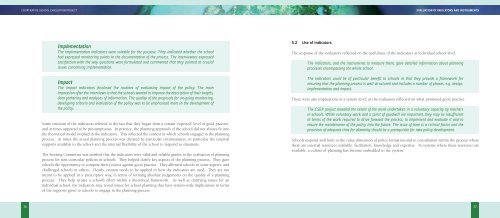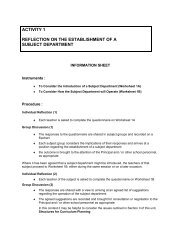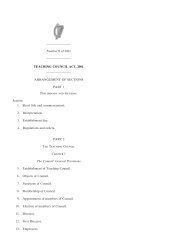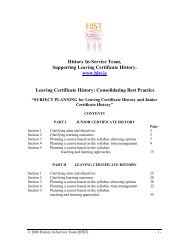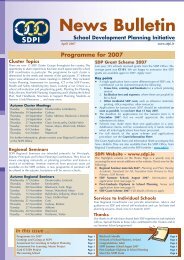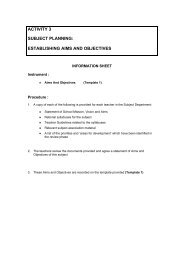Co-Operative School Evaluation Project (File Format PDF 550KB)
Co-Operative School Evaluation Project (File Format PDF 550KB)
Co-Operative School Evaluation Project (File Format PDF 550KB)
You also want an ePaper? Increase the reach of your titles
YUMPU automatically turns print PDFs into web optimized ePapers that Google loves.
COOPERATIVE SCHOOL EVALUATION PROJECT<br />
EVALUATION OF INDICATORS AND INSTRUMENTS<br />
Implementation<br />
The implementation indicators were suitable for the purpose. They indicated whether the school<br />
had expressed monitoring points in the documentation of the process. The interviewees expressed<br />
satisfaction with the way questions were formulated and commented that they pointed at crucial<br />
issues concerning implementation.<br />
Impact<br />
The impact indicators disclosed the routines of evaluating impact of the policy. The main<br />
impression after the interviews is that the schools wanted to improve the description of their targets,<br />
data gathering and analyses of information. The quality of the proposals for on-going monitoring,<br />
developing criteria and evaluation of the policy was to be emphasised more in the development of<br />
the policy.<br />
Some criticism of the indicators referred to the fact that they began from a certain ‘expected’ level of good practice,<br />
and at times appeared to be presumptuous. In practice, the planning approach of the school did not always fit into<br />
the theoretical model implied in the indicators. This reflected the context in which schools engaged in the planning<br />
process. At times the actual planning process was dictated by particular circumstances, in particular the external<br />
supports available to the school and the internal flexibility of the school to respond to situations.<br />
The Steering <strong>Co</strong>mmittee was satisfied that the indicators were valid and reliable guides to the evaluation of planning<br />
process for non-curricular policies in schools. They helped clarify key aspects of the planning process. They gave<br />
schools the opportunity to compare their process against good practice. They affirmed schools in some aspects, and<br />
challenged schools in others. Clearly, caution needs to be applied in how the indicators are used. They are not<br />
meant to be applied in a prescriptive way, in terms of forming absolute judgements on the quality of a planning<br />
process. They help situate a school’s effort within a theoretical framework. As well as clarifying issues for an<br />
individual school, the indicators may reveal issues for school planning that have system-wide implications in terms<br />
of the supports given to schools to engage in the planning process.<br />
5.2 Use of indicators<br />
The response of the evaluators reflected on the usefulness of the indicators at individual school level.<br />
The indicators, and the instruments to measure them, gave detailed information about planning<br />
processes encompassing the whole school.<br />
The indicators could be of particular benefit to schools in that they provide a framework for<br />
ensuring that the planning process is well structured and includes a number of phases, e.g. design,<br />
implementation and impact.<br />
There were also implications at a system level, as the evaluators reflected on what promoted good practice.<br />
The CSEP project revealed the extent of the work undertaken in a voluntary capacity by teachers<br />
in schools. While voluntary work and a spirit of goodwill are important, they may be insufficient<br />
in terms of the work required to drive forward the process, to implement and evaluate it and to<br />
ensure the maintenance of the policy into the future. The issue of time is a critical factor and the<br />
provision of adequate time for planning should be a prerequisite for new policy development.<br />
<strong>School</strong>s respond well both to the value dimension of policy formation and to consultation within the process where<br />
there are external resources available: facilitation, knowledge and expertise. In systems where these resources are<br />
available, a culture of planning has become embedded in the system.<br />
36<br />
37


